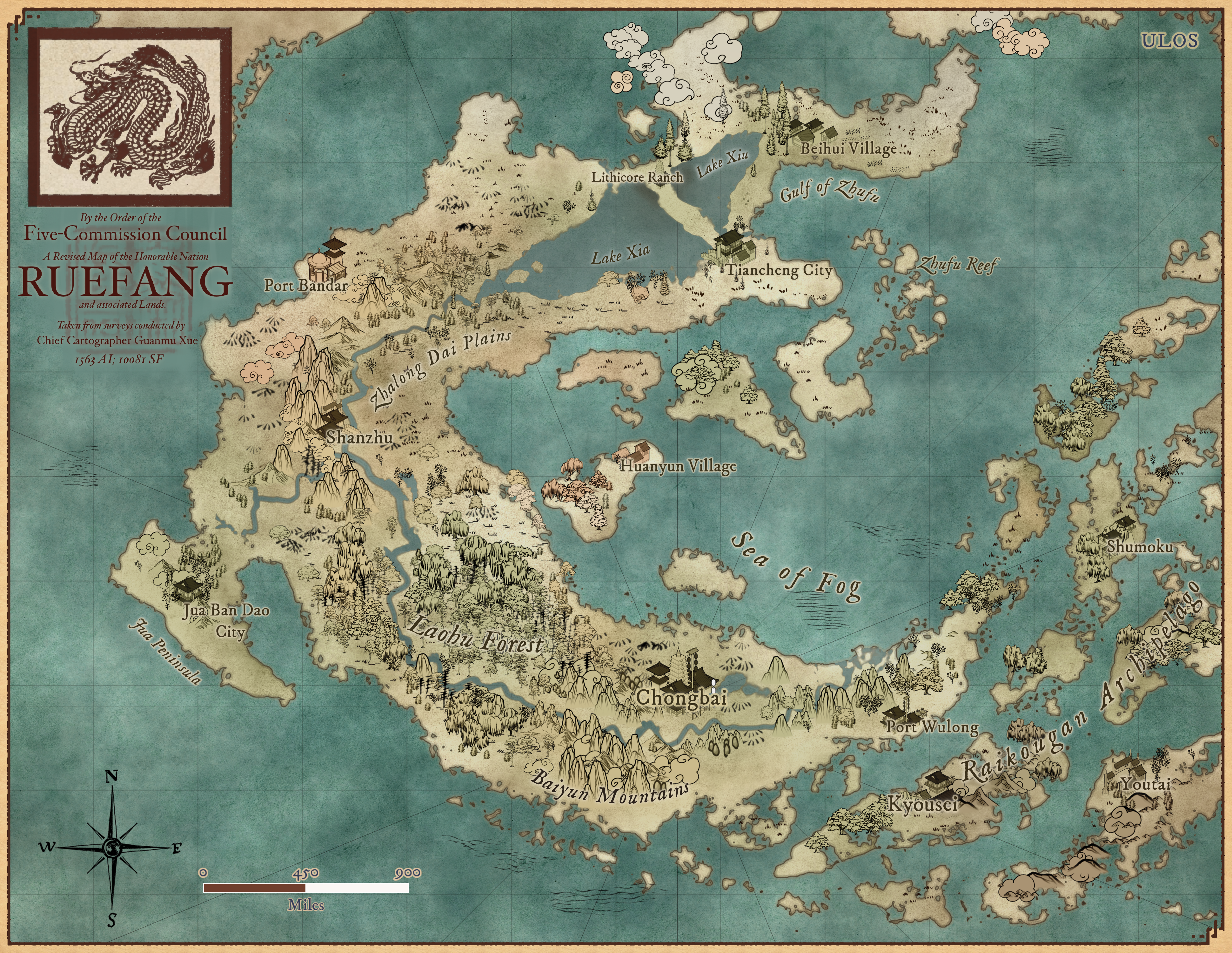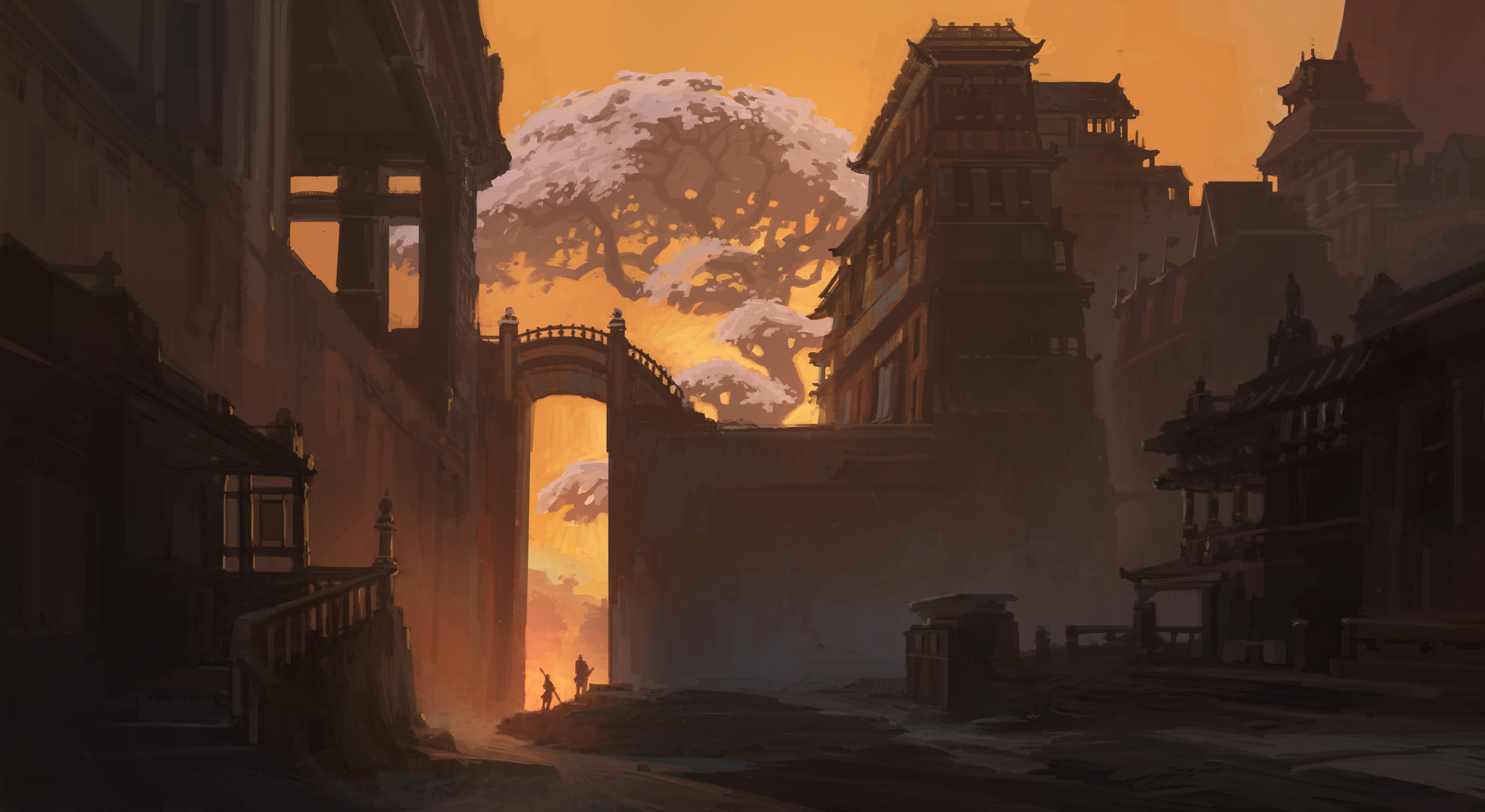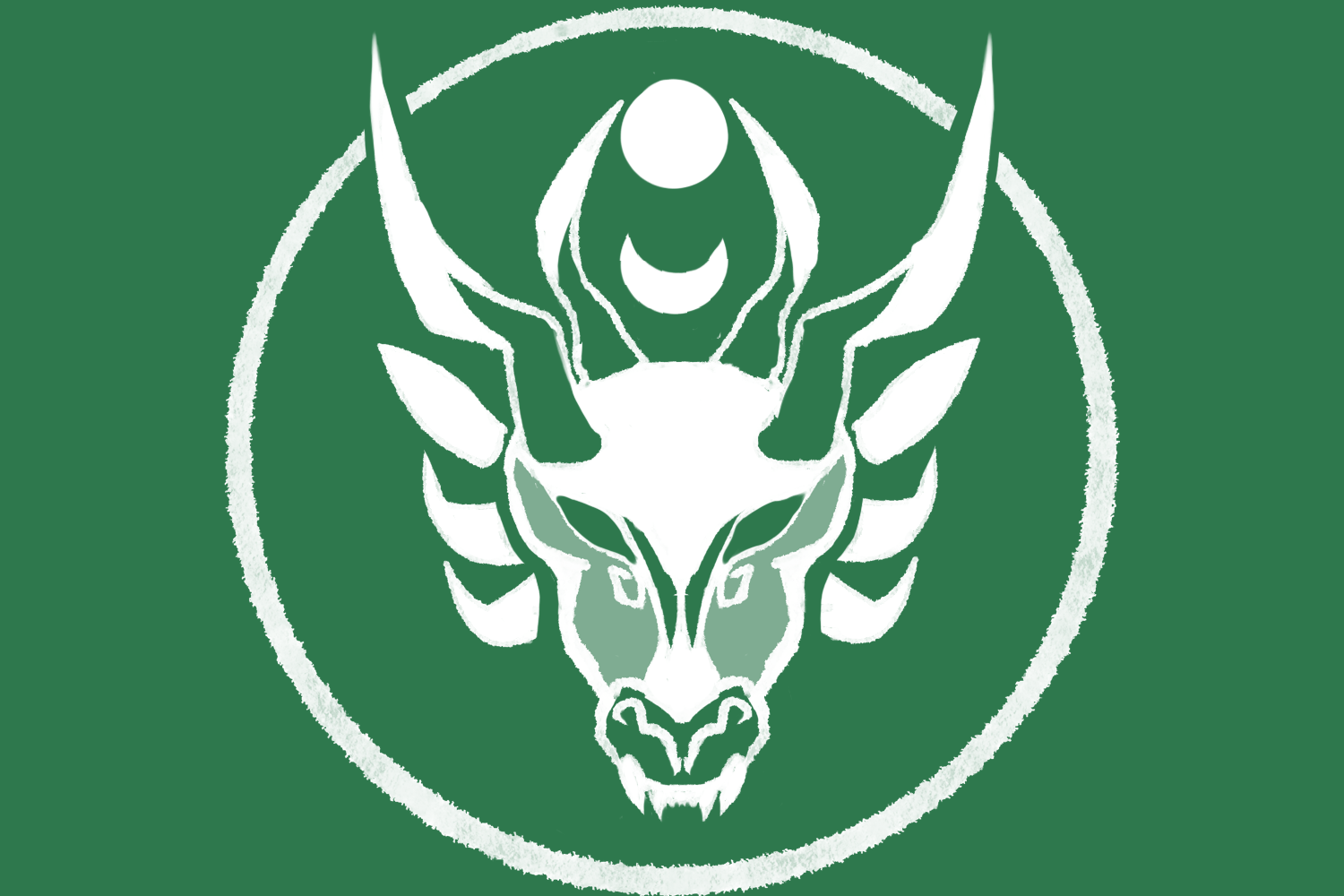Table of Contents
Ruefang
- Government Type: Oligarchy
- Symbol: Long
- Major Races: Draconic Lizards, Elves
- Capital: Chongbai
- Demonym: Ruefangren
A map of Ruefang, circa 2557.
Overview
Ruefang's climate is fairly diverse, ranging from a temperate forest in the north to vast, central plains to the tropical Laohu Forest in the south. To the east is the Raikougan Archipelago, a mostly temperate island group with an unusually stormy climate. There are two large lakes in Ruefang: Lake Xía, the larger of the two to the west, and Lake Xiu. The crescent-shaped landmass hugs the aptly named Sea of Fog, which is covered by thick mists. The wilds of Ruefang are nearly completely uninhabited due to the threat of unstable, magical leylines; the vast majority of the population resides in urban or suburban centers. Ruefang is loosely based on the real-world countries of China and Japan.
The country is governed by the Five-Commission Council, operating out of Chongbai. The Councilors, sometimes also known as Commissioners, are some of the most powerful people in the entire nation. The current Commissioners are:
- Zheng Chen, Commissioner of Sorcery
- Jin Xinyi, Commissioner of Trade
- Wang Tu, Commissioner of the Divine
- Acting Commissioner Tapatahi Tawhiri, Commissioner of Justice
- Bailin Howard, Commissioner of Development
The landscape of the Commissions was quite different before the 2557 Ars Machina Incident and the secession of the Raikougan Archipelago from the mainland. There were five Commissions in total, with a Commission of Industry led by Zuanshi Hua, sister of major industrial leader Zuanshi Wei, and a Commission of Raikougan formerly led by the archipelago Shogun.
After the Ruefang-Raikougan Second War and the dissolution of the Ruefang Continental Army, the structure changed to what we see today. The army of the nation is managed by the Commission of Justice, and decisions regarding war are made by the entire Council.
Ruefang is also home to the College of Mages and Scholars (CMS), a renowned higher education institution across Cahyali. In addition to studying the arcane, they teach a variety of mundane subjects and run many branches not only across Ruefang, but in Ulos and Ley'Ork as well. They are primarily known for their advancements to the field of the primary elements and history of Cahyali. They are also known for their philosophers and academic writers. The CMS has five divisions:
- Hekemai, studying science, technology, engineering, and applied mathematics.
- Tangata, studying liberal arts including history, literature, and the social sciences.
- Whetu, studying varied forms of elemental, divine, and psionic magic.
- Mata, studying martial arts and the art of war. On Cahyali, the warrior's School of the Dragon was developed by the CMS Mata Division. Has a branch location in Shanzhu, where they collaborate with the Ruefang Continental Army (RCA).
- Ora, studying life, death, and the environment, with a focus on biology and alchemy.
The national flag of Ruefang.
Regions
Ruefang is broken down into four broad regions. As of the late 2550s, the newly established Commission of Development is sponsoring a frontier project, encouraging citizens to go out, survey, and settle in the newly habitable land.
Xiaxiu Lakes
The Xiaxiu area is one of the cooler places on Ruefang, with snow falling regularly in the winter. The large Lakes Xia and Xiu are the main draw of this region, in addition to the Zhufu Reef off the eastern coast. The Xiaxiu region subsists mainly on fishing and cultural exports.
Zhalong Dai Plains
Zhalong Dai covers the majority of central Ruefang, and is mostly a vast, flat place varying from semi-arid in the north to subtropical in the south. In the west is the Shanzhu karst range, sometimes termed the Shanzhu Spine, where the eponymous city is built. Cutting through the center of the plains is the Great Long River. To the far west is the Jua Peninsula, a fairly temperate place. The Zhalong region is sparsely populated outside of its cities, and what small tribes do exist maintain a nomadic, horse-mounted life.
Laohu Forest
Named for populations of fierce tigers living within its borders, this dense and lush rainforest was utterly uninhabitable for centuries following the destabilization of Ruefang's leylines, and has only recently become stable again. The depths of the forest still remain mysterious and dangerous, but more treasures than dangers are hoped to reside within the lush walls.
Baiyun Region
This place encompasses the Baiyun Mountains and all land east of that range, one of the most prosperous places in Ruefang. With a warm subtropical climate, Baiyun is fit for growing much of the food for Ruefang, and is termed the “rice bowl” of the country. Other than agriculture, the Baiyun region exports industrial goods and fish. It is home to the capital of Ruefang, Chongbai.
Laws
Laws come into full effect when a citizen of Ruefang reaches the age of 16, which is also the drinking age. Children are still bound by Ruefang law, but will usually receive reduced sentences. The laws are as such:
- Theft: 5-10 days incarceration and/or a fine equal to the worth of the stolen goods.
- Disrespecting the outcome of a mutually consented duel: 12 days incarceration and severe loss of face.
- Violation of consent in a duel: 30 days incarceration and an additional consequence chosen by the victim or victim’s family.
- Open worship of demons, eldritch beings, or fey entities: 1-2 years incarceration and a fine of 800 gc.
- Damage to property, private or governmental: 3 months incarceration and a fine equal to twice the worth of the property destroyed.
- Ownership of another intelligent humanoid creature: Incarceration or exile from Ruefang for life.
- Assault: 10-15 years incarceration.
- Murder and rape: Incarceration for life, or execution (depending on degree).
- Treason: execution.
Dueling laws are extensive and complex, as they make up much of Ruefang's system of personal conflict resolution. However, in most cases the legality of a duel can be summed up by mutual consent between the dueling parties regarding the form and stakes of the contest.
For more information on the history and culture of Ruefang, follow this link: Ruefang History & Overview
The outskirts of Chongbai at sunset. By Andreas Rocha; used with permission.
Cities of Continental Ruefang
Chongbai, Twice-Built Reigning Crown: Population 3.5 million. The sprawling capital of Ruefang, host of the Five-Commission Council and much of the country's industrial activity. Built at the southeastern end of the vast, unexplored Laohu Forest and nestled at the edge of the Baiyun Mountains, Chongbai has access to the seas via the nearby River Baiyun. After the destruction of Ruefang about 1,500 years ago, Chongbai was the first of the destroyed cities to be rebuilt and has remained the venerated capital ever since.
- Lo Village: Population ~100. A small, secluded village about 200 miles west of Chongbai. Located on top of a leyline, the village was founded around an ancient temple to an unknown deity known as the Beast. In recent years though, Zuanshi Ironworks set up a laboratory within the temple due to its proximity to a leyline. The laboratory has since been abandoned, and the villagers still experience the repercussions of their experiments.
Tiancheng, Home of Years and Magic: Population 2 million. An amphibious city, inhabited by both elves and semi-aquatic lizards - and built half above and half below water. Tiancheng was saved from the Fist of God calamity by a massive shield built just in time by visiting Ulosian mages. By avoiding the destruction, eons of history and culture were preserved. Ever since, Ulos has had a strong influence on the culture of the city. The central branch of the College of Mages and Scholars is located here.
- Lithicore Ranch: Population 20,000. A corporation-run company town near Tiancheng City. Essentially a small oligarchy of its own, the city’s mayor/CEO is Charles Lithicore III, a Jaernian who makes his profits in the mining industry. The city is almost entirely centered around its mines as a result of this. Residents of Lithicore Ranch rarely, if ever, leave the town, and as of late the activities of Lithicore Mining, Ltd. have raised worries with the more environmentally-conscious Tiancheng residents.
Jua Ban Dao City, Hand of the Heavens: Population 500,000. Relatively isolated on a peninsula of the same name, Jua Ban Dao City is the birthplace of many of Ruefang's monastic orders. The city is the religious center of Ruefang, with temples to every major god being found within walking distance of each other. In recent years, foreign tourists have taken an interest in this city, leading to some tension between leaders who desire to keep true to ancient culture and those who embrace the tourism industry and the modernization it brings.
Shanzhu, Bastion Within Clouds: Population 3 million. Not only is Shanzhu the military center of Ruefang and the home to the country's largest and most secure prison, it is built nearly a thousand feet above ground on the peaks of karst pillars that soar high above the Zhalong Dai plains. The rich live at the penultimate peaks of this city, while the poor live - quite literally - below them. As breathtaking as Shanzhu may be at first, one must not forget that it was built as a prison and remains incredibly functional as such.
Port Wulong, Gate to the Sea: Population 1 million. Located at the southeastern end of Ruefang, Port Wulong acts as the gate between continental Ruefang and the Raikougan Archipelago. A bustling harbor, it is known to “never sleep”; there is always something happening at all hours of the day.
Port Bandar, Gate to the Sands: Population 750,000. A ways west of Lake Xia, Port Bandar is the closest settlement on Ruefang to the desert lands of Dahabu. Many Dahabi have settled here, giving the city a unique culture and population makeup. It acts as a port city between Ruefang and Dahabu, but is far sleepier than Port Wulong in the south - after all, few remain on Dahabu.
Huanyun Village: Population 6,000. A sleepy, peaceful village on a small island within the Sea of Fog. Huanyun mostly provides for itself through subsistence farming and fishing, and researchers from Tiancheng and the CMS often come through as a pit stop to the center of the Sea of Fog, where the Ruefang leyspring is centered. Only some of these mages return.
Beihui Village: Population 3,500. Beihui is the northernmost settlement in Ruefang, located closest to Ulos. For Ulosian mages traveling into Ruefang to study the leyspring phenomenon, Beihui is usually their first stop. Apart from the occasional Ulosian trade activity, though, Beihui is a tiny and rural settlement, full of superstition and proverb regarding the leyspring and magic itself. Most Beihui residents are extremely skeptical of industry.
Culture
Honor & Art
The culture of Ruefang has deep roots in martial tradition, and one of the most significant concepts is “honor”. To act honorably is a subjective topic, but maintaining an honorable reputation will help one greatly in Ruefang society. There are relatively few mages in the country, with most fighters training for years as samurai or soldiers.
Saving face in Ruefang is, therefore, very important. While some crimes have light corporal sentencings, they are accompanied by a severe loss of face, and word gets around in the cities of Ruefang. To ruin one’s reputation in this country is tantamount to ruining much of their life.
On Cahyali, the techniques of the School of the Dragon were in fact developed on Ruefang for the purpose of battling ley-touched monsters and later adapted for use against humanoid mages when the techniques spread outside Ruefang. On the other hand, inquiry into the arcane is somewhat underdeveloped in most of Ruefang as compared to the rest of the world. Those who can perform magic are regarded with some skepticism by older generations, but the vast majority of the populace sees mages as just another form of trained, disciplined artist.
Religion
Like much of Cahyali, Ruefang is not a particularly devout nation. The gods are treated mostly with transactional relationships; most believe that through worship and offerings, one can get a god to give you what you want. Organized religion comes in the form of a plethora of monastic orders, the members of which are treated mostly well but not really believed to wield divine power. The most heavily worshiped gods are Zepherin, Marutuk, and Vahrun.



